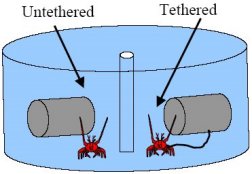Staying Away from Sick Lobsters
Lobsters detect and shun potential roommates that are infected with a virus.
By Emily Sohn
Lobsters may have a sick sense.
New experiments show that certain kinds of lobsters avoid sick individuals even before the infected lobsters are contagious or show symptoms that people can see. It’s the first evidence that healthy wild animals detect and shun sick members of their own species.
 |
|
Caribbean spiny lobsters are social and prefer to share dens, as shown by these young lobsters gathered together under a sponge. |
| Photo by Mark Butler, Old Dominion University |
Caribbean spiny lobsters live in the sea between Bermuda and Brazil. Unlike North Atlantic lobsters, they’re social. Some populations march single file in a long line along the ocean floor for miles every autumn, looking for deeper, calmer waters.
These lobsters also share dens, where they hide and protect each other from intruders. When something invades their space, they fight back by poking their long, stiff antennae at it.
“They’ll drive the antennae into the flesh of fish—or of researchers,” says Mark Butler of Old Dominion University in Norfolk, Va. He says that collecting the creatures is “like trying to grab a porcupine out of a crevice.”
In 1999, one of Butler’s colleagues noticed that sickly young lobsters tended to live alone. They were low in energy, and their shells were discolored. Eventually, he and another lobster expert figured out that these lobsters carried a virus called PaV1. It’s the first virus known to strike lobsters.
 |
|
Caribbean spiny lobsters are normally active and social, but when sick with a virus (like the lobster in the photo), they move about more slowly, become discolored, and tend to live alone. |
| Photo by Don Behringer, Old Dominion University |
The virus spreads when lobsters touch each other. Young lobsters can also catch the virus through seawater.
In a lab experiment, researchers found that more than 60 percent of lobsters living with infected partners died within 80 days.
In another study, in which scientists surveyed a population of spiny lobsters in the wild, they found that more than 56 percent of healthy lobsters shared hiding places, but only 7 percent of sick ones did.
A recent set of lab experiments then showed that infected lobsters didn’t care whether they shared a hiding place with a healthy lobster or with another sick one. More than 60 percent of healthy lobsters, on the other hand, avoided companions that had become infected 4 weeks earlier. At this stage, researchers couldn’t detect any symptoms in the infected lobsters.
 |
|
In this lab experiment, lobsters were given a choice of a shelter with a tethered lobster, either healthy or infected, or an empty shelter. Healthy lobsters overwhelmingly picked the empty shelter when the other shelter contained an infected lobster. |
By the time the sick lobsters had been infected for 6 weeks, all healthy lobsters refused to hide near their infected pals. Lab tests show that the virus becomes contagious 8 weeks after a lobster becomes infected.
Rudeness doesn’t appear to be a concern for these creatures. Instead, avoiding sick roommates is a strategy for survival.—E. Sohn
Going Deeper:
Milius, Susan. 2006. Lobster hygiene: Healthy animals quick to spot another’s ills. Science News 169(May 27):325-326. Available at http://www.sciencenews.org/articles/20060527/fob6.asp .
For additional information about how spiny lobsters react to sick neighbors, go to www.odu.edu/oduhome/news/spotlight56.shtml (Old Dominion University).
You can learn more about the Caribbean spiny lobster at marinebio.org/species.asp?id=155 (Blue Ocean Institute).







